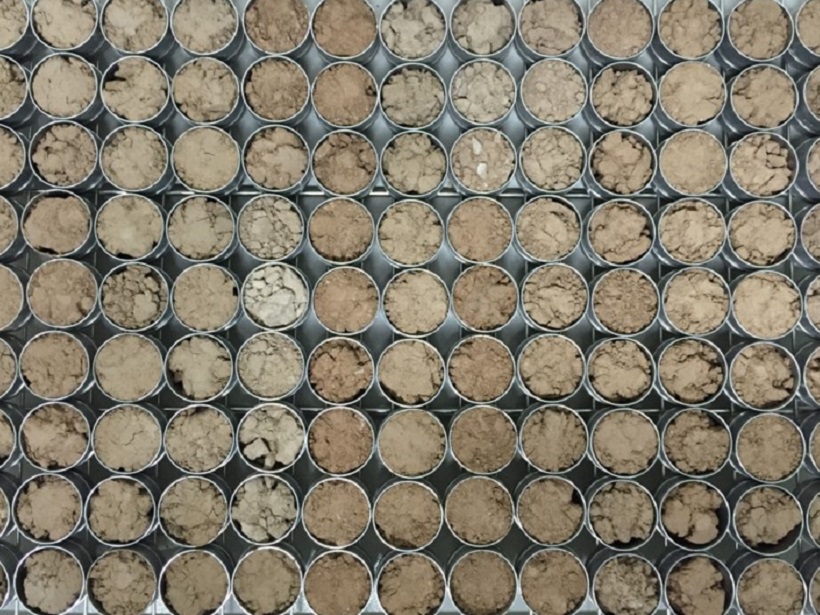Soils can be analyzed according to many different physical properties, among them their thermal and hydrologic properties. A recent paper in Reviews of Geophysics describes how the development of heat pulse methods over recent decades has furthered our ability to make and interpret the physical measurements of soil. Here, some of the authors answer some questions about these methods, and describe developments in instrumentation and modeling.
Why is it useful to understand the thermal properties of soils?
The thermal properties of soils include thermal conductivity, volumetric heat capacity and thermal diffusivity. These properties affect the soil temperature regime and temperature-dependent soil processes such as decomposition of organic matter by microbes, soil nitrification or de-nitrification and release of greenhouse gases from soil, and plant root growth rates.
Understanding soil properties and their effects is important for a range of applications. For example, accurate measurements are crucial for designing civil infrastructure in cold regions, tapping into geothermal energy resources, managing underground radioactive waste disposal, planning for geological carbon dioxide sequestration, and recovery of natural methane gas hydrates. Soil thermal properties are also prerequisites in many hydro-meteorological models and community land surface models. Beyond Earth, measurements of thermal properties have been included in space missions to the Moon and Mars.
What different methods can be used to measure the thermal properties of soils?

There are two main categories of method: steady-state/stationary and transient/non-stationary.
The steady-state method is based on the theory of steady flow of heat, and thus requires maintaining a constant temperature gradient (usually one-dimensional) across a sample.
It also requires thermal insulation to minimize edge or end effects, and a relatively long time to attain thermal equilibrium.
Transient methods measure the temperature response of the soil to a heat pulse from a heat source inserted into soil.
The most widely used transient method, is referred to as the heat pulse method. The duration of applied heat for the heat pulse method is much shorter than that for the steady-state methods. It is a rapid, accurate, portable, low cost and low energy way to perform laboratory and field measurements of soil thermal properties.
How does the heat pulse method work?
There are two ways in which this method works: single probe heat pulse (SPHP) and dual probe heat pulse (DPHP). Both consist of a heat source and at least one temperature sensing device The heater is supplied with a constant electrical current for a specified period of time, and the temperature sensor(s) records the temperature with time changes. These sensors can be used to measure the different thermal properties of soil, as well as soil water content and soil bulk density (see figure below).

Both the SPHP and DPHP methods have their strengths and weaknesses. A SPHP sensor can be long or short, and thus can have a range of sampling volumes. It is also robust, alleviating the error due to needle deflection which can occur with the DPHP method. Unfortunately, the SPHP sensor can only be used to accurately determine thermal conductivity.
Meanwhile, the DPHP sensor has a small sampling volume, and because of that, it is irreplaceable in sap flow measurements, and in measuring subsurface evaporation occurring in the 0 to 5 cm soil layer, which is a process not possible to determine and to understand with other tools. For other processes, the DPHP may be limited by the small measurement volume and its shortcomings for use to describe large areas of soil.
What have been some of the most significant research advances in this field?
There have been major advances in the heat pulse method, especially the DPHP method, in the past 30 years. Not only has the heat pulse method proven effective for measuring all three thermal properties of soil, as well as soil water content, and potentially soil bulk density, but it has also been used to measure soil water flux and heat flux, allowing for partitioning of evapotranspiration into transpiration through sap flow measurements and to soil water evaporation (see figure below). Notably, progress has been made in measuring soil ice content and latent and sensible heat fluxes within soil.

DPHP has also become an important sensor for characterizing hydrological processes. For example, DPHP probes can be combined with time domain reflectometry or frequency domain reflectometry to make multi-purpose sensors. Furthermore, the passive or actively heated fiber optics for distributed temperature sensing extends the capability of heat pulse methods to field scales and offers new possibilities for multi-scale characterization of soil thermal properties and monitoring of soil water dynamics.
What are some of the unresolved questions where additional research, data or modeling is needed?
In terms of equipment, current probes have limitations, so new and innovative probes need to be designed that improve the versatility of heat pulse methods and their applications in Earth and environmental sciences and engineering research. One particular area of research is extending the range of the heat pulse method into partially-frozen soils.
In terms of modeling, efforts are being made to improve data interpretation and error analysis modeling (e.g., thermal contact resistance). Evaluating and calibrating available thermal conductivity models that are developed from steady-state measurements, and developing new models based on the heat pulse measurements are needed. Such models can be used to estimate soil thermal properties for a range of soil conditions and be incorporated into sophisticated numerical simulation models for larger scale applications.
—Hailong He (email: [email protected]), College of Natural Resources and Environment, Northwest A&F University, China; Bing Cheng Si, Department of Soil Science, University of Saskatchewan, Canada; and Robert Horton, Department of Agronomy, Iowa State University, USA
Citation:
He, H.,Si, B. C., and Horton, R. (2018), Taking the pulse of soil, Eos, 99, https://doi.org/10.1029/2018EO107029. Published on 26 October 2018.
Text © 2018. The authors. CC BY-NC-ND 3.0
Except where otherwise noted, images are subject to copyright. Any reuse without express permission from the copyright owner is prohibited.

